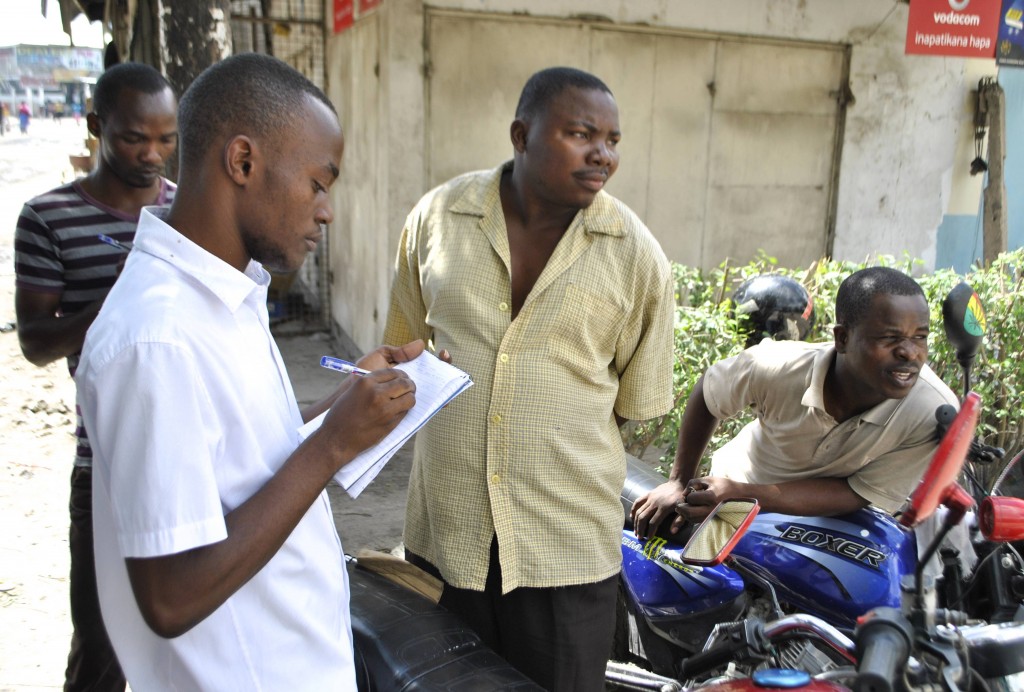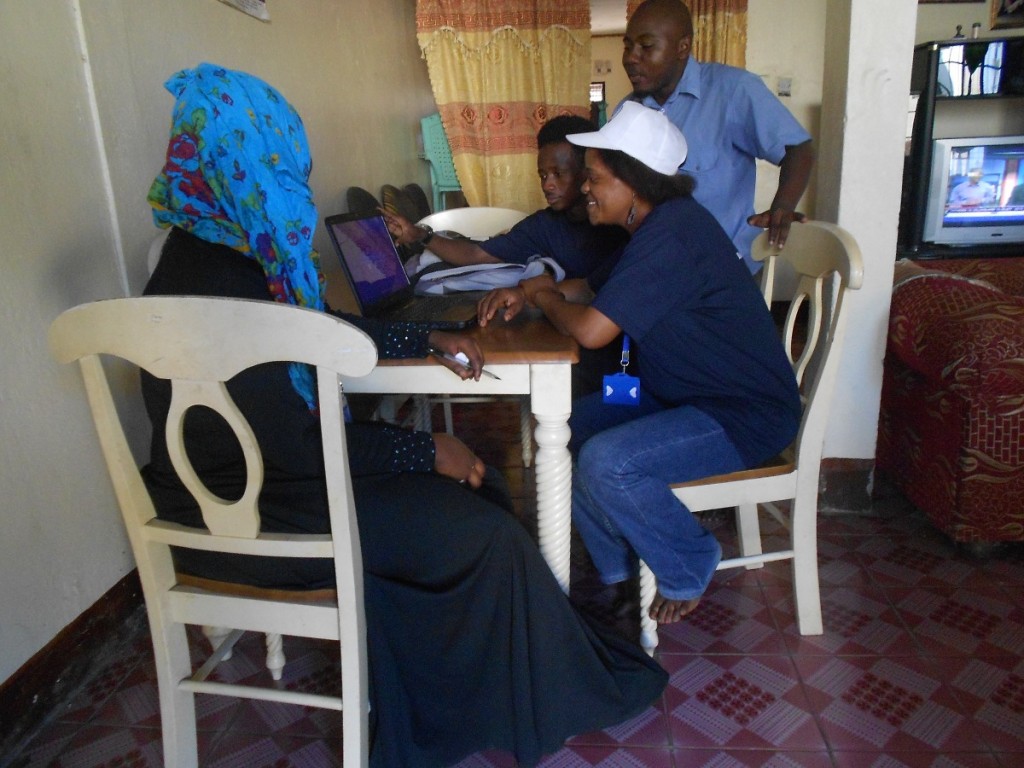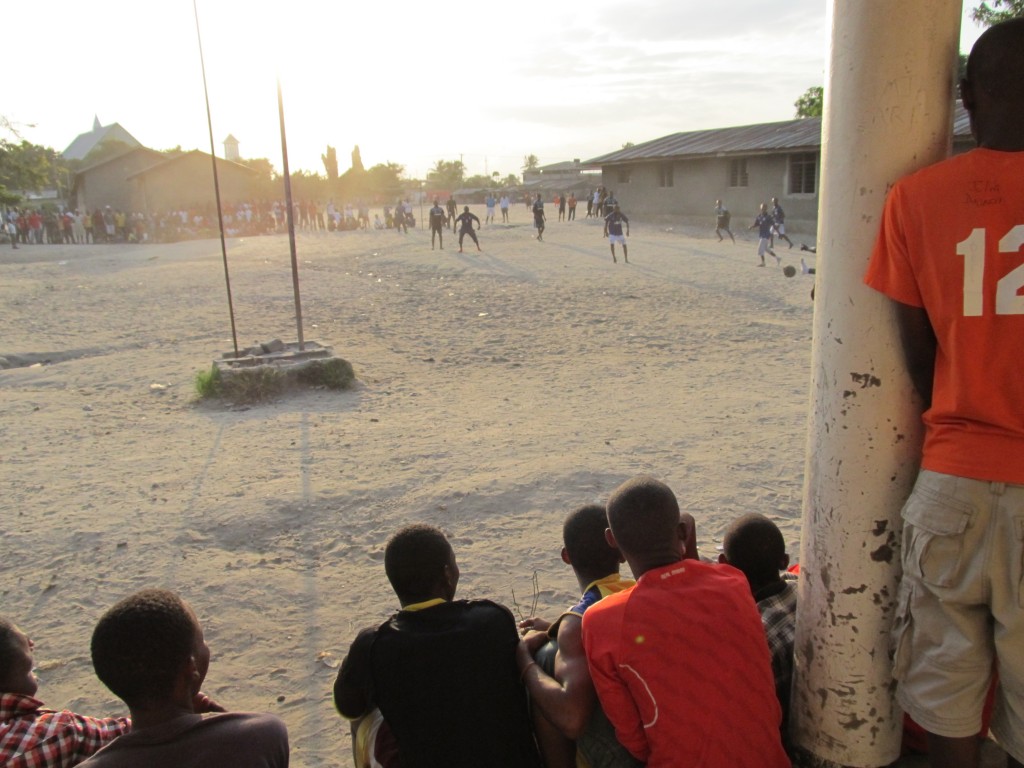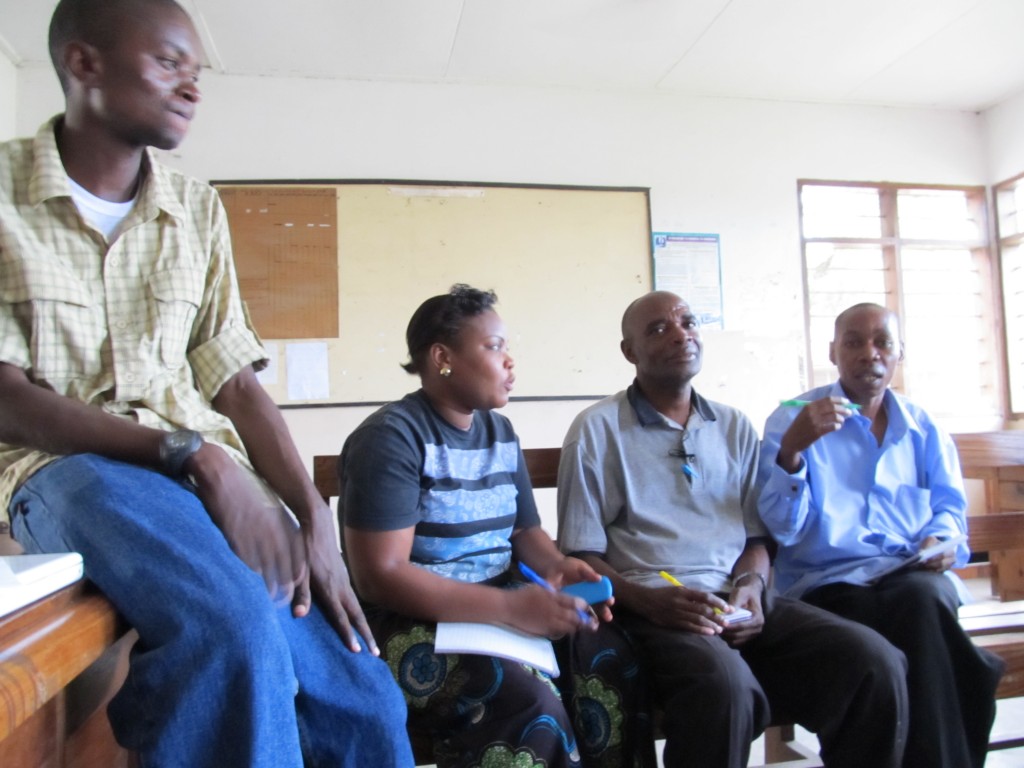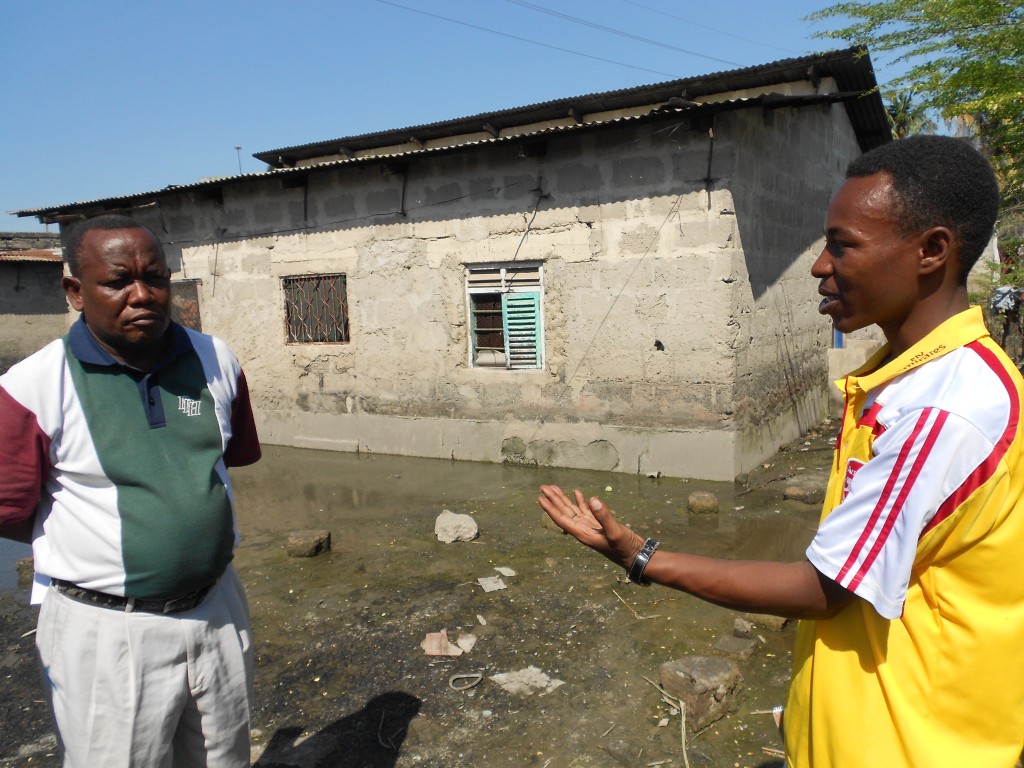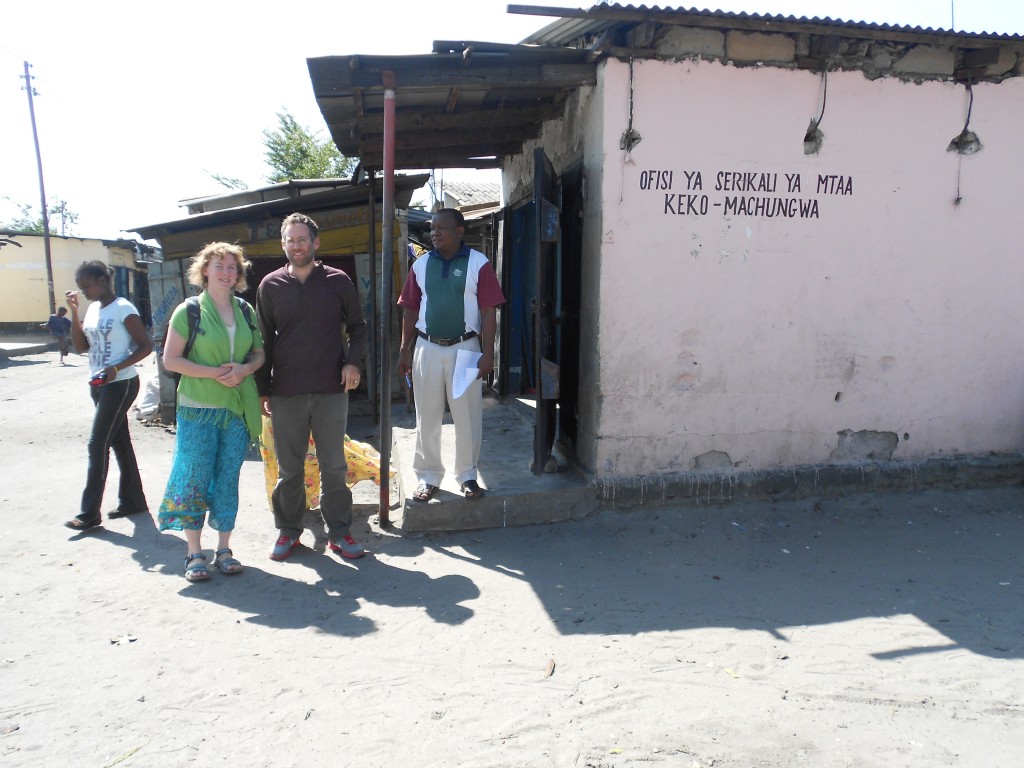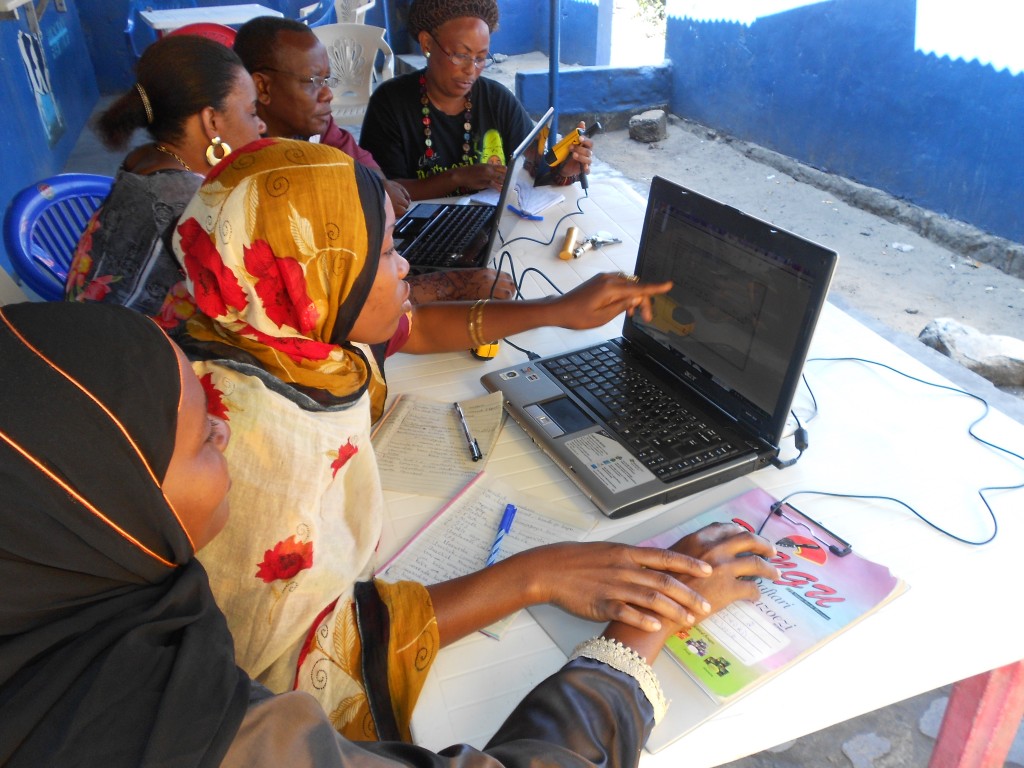The Funding Conundrum: Why Funding for ICT for Development Needs to Change
Posted: October 9th, 2013 | Author: Erica Hagen | Filed under: citizen feedback, Tanzania | 8 Comments »On a recent post, I talked about how effective feedback loops are close to being realized in Dar es Salaam.
In this post, I discuss the challenges facing this type of work today – specifically, the serious problems with the current landscape of funding in technology for development, and how we hinder progress in getting from flash-in-the-pan pilots to meaningful change.
In Dar es Salaam, GroundTruth began as a consultant to a pilot initially conceptualized and supported by the World Bank. We’ve supported it to an extent now independently (and voluntarily) for three years. In spite of having very engaged community members, having met with prominent members of government who have a strong interest in the information, and getting some local notoriety, as well as a good amount of international attention, the ultimate work of creating a strong feedback loop has yet to be done.
What’s going on?
Well, here’s how funding tends to operate when it comes to technology for development or feedback projects:
Step One:
- A tech pilot concept is developed and funded by a large organization or institution, lasting no more than a couple of months. The concept can be initiated by a smaller partner NGO or by the big organization or institution, or even by a funder.
- OR: a project contest, hackathon or app contest is initiated, sponsored and publicized by a funder or large agency. The contest may come with some funding as a reward.
Step Two:
- The winner of the contest or the implementer of the pilot works on the idea, and if there is enough funding, tries it out in the field. This involves – or should involve – real people, and real communities. It’s possible that they get some results, usually in the form of uptake by citizens – there are reports posted to their online reporting tool, SMS sent in, apps tried out, used and maybe even tinkered with based on feedback.
Step Three:
- Blog posts are written about the nascent success, and a conversation is started about what this can potentially contribute to the feedback loop or target social issue. Publicity helps raise awareness of the pilot. Social media lights up, conferences are attended and lightening talks are made.
Step Four:
- That’s it! The funding fades and the world moves on to the next new thing. (Here is a humorous take on this published today by ICT Works).
Of course, there are some attempts to provide sustained funding for important ideas – there’s the Grand Challenge model, for instance. But more commonly, ideas that are proven to be good languish in a post-hype slump, while backers search for the Next Big Thing (or, Next New Thing). In some ways this is a chronic issue in development funding. But when it comes to technology, it’s much worse, simply because the focus tends to be on the technology itself – not on the program design, context or thornier issues in the society which created the problem in the first place. And, as we all know from our own lives, technology is indeed a quick fix and changes almost daily. Suddenly we can communicate instantly with thousands of people or book plane tickets in a few seconds from our phone. Why should it be any different for efficiently solving a social problem? And, shouldn’t any project be almost immediately “scaleable†– taken to a huge number of people or places very quickly – just like an iPhone 5 or Pinterest?
But creating actual social impact with the help of a technology is, clearly, a completely different ballgame. While we should know that, many are blinded by the potential for continuous (and cheap) experimentation which continuously boosts the profile of the associated agencies – simply because the news cycle highlights the “new†and “buzzworthyâ€.
The temptation of quick and inexpensive (if superficial) impact and great PR is proving to be too much to resist.
Unfortunately, lost in the storm are not only the potentially transformative projects, but the people who took part in the pilot phase in the first place. Those people are the citizens, the residents, the community members, the real people who hoped they had something to gain from putting effort into association with a promising pilot. Is it really responsible – or ethical – to ditch such an effort before it has time to bear fruit? No – which is why many participants in this funding cycle keep trying to serve their public in spite of such immense resource challenges.
And the final blow is that the same funders continue to serve the cycle of the new, while tending to blame the initial developers and implementers for not creating something that’s going to operate on its own sans grant funding. That is, something marketable. Or, that proves its own worth in a matter of months and thereby becomes something the public will pay for, or requires no money because of extensive volunteerism. In my view, this fallacy is akin to saying that public libraries don’t deserve public funding because people should pay to access books and information if they truly value them (or they should manage and run their own free-braries). But that’s another post.
Many technology interventions can indeed create an attractive output that appears online quickly and relatively easily, whether or not the ground reality has changed at all. This is different from most development areas – health, education – whose challenges resist even the illusion of a quick impact.
Where we need to concentrate resources now is on those organizations and individuals who have gotten past the first three, four, five iterations of a technology intervention and that attractive output – the projects where a constituency of support has already been built up at the grassroots level.
This isn’t just us – I’ve met countless inspiring people often working in their own backyards on real feedback loops and real impact from collective citizen voices amplified by technology. Most of the time, what I hear is this same story – their potential is severely limited because after the initial buzz, there wasn’t any more funding. While one might think that a good project will somehow manage to attract the support it needs, that’s just not always the case. There are indeed resources out there which are being spent on technology and development, but they are not being directed toward those people already making a real difference, nor are they targeted at the post-pilot phase – which is not the same as the “scaling up†phase. I would call it the “impact phase†– putting in the hard work needed to create a tangible effect and close the loop of feedback, leaving a real mark on society. This might happen in year 2, 3, or 4 of a project, not year one.
We’ve had the surreal experience of watching a presentation in Washington which happened to show our Dar es Salaam pilot as an example of a great success, while we were chatting online with a project participant and learning that our entire stock of computer equipment had been destroyed in a flood, and therefore any chance of the pilot reaching its potential was nearly eliminated unless we could somehow get them new equipment. We started asking around for donations, and thankfully friends at a small tech company contributed two laptops. The project has now been kept going on just those two laptops for over a year now. This is great – but clearly limited. I think it shows that the nitty gritty of getting any of these ideas to work is ALWAYS much more difficult than it might initially appear. It requires a stronger commitment than anyone anticipates when they first realize that technology could become a game-changer in development.
It’s complicated: in our case, there has indeed been interest to push forward from this pilot on the part of those we started out with at the World Bank. But there are often problems with having large institutions involved with small experimental pilots, which require strong adaptability and agility – within the organization as well as externally. For one reason or another and after various attempts, there hasn’t yet been a successful channel for taking it forward to the impact phase.
Unfortunately, it’s quite common for pilots that have great potential and international fanfare to stall and not go much further than that. I understand the real need for serious thinking and research on how to create that elusive impact – how to complete the loop – and for much, much better evidence and stronger theories of change. But that is the level at which we should be experimenting and piloting by now. And that is where funding needs to be directed. This field is no longer new – there are many, many pilots which need to take the experimental mindset to the next level of closing the loop of impact. Let’s give them our support.
GroundTruth in Dar es Salaam: Six Lessons for Effective Feedback Loops
Posted: August 30th, 2013 | Author: Erica Hagen | Filed under: citizen feedback, tandale, Tanzania | 2 Comments »Closing the Gap with Decision Makers
I was recently in Dar es Salaam, Tanzania, examining the potential for a “feedback loop†in some of the regions where GroundTruth has worked, particularly in Tandale, and Keko Machungwa, two informal settlements.
GroundTruth hasn’t had a formal program running in Dar, but since our mapping project in 2011 we’ve supplied the community group with computer equipment and supported a local student participant, Msilikale Msilanga, to help out on a regular basis, resulting in a fantastic community blog. We also provided some technical support to the local chapter of Slumdwellers International to do their own mapping in Keko Machungwa.
The information outcomes in both pilot areas have been quite impressive—they are much more visible now, and community members can work with information in ways that it’s usually assumed only experts can manage. But we also knew that the potential for transformation on the ground would require, at a minimum, closing the gap between the community and those who could respond to their needs.
While there, I worked with volunteer Brielle Morgan and Msilikale to provide extra training for the key Tandale bloggers, and to help the group in Keko create their own blog. Then, we discussed the specific goals they wanted to achieve through their information work, their motivations, and how they imagined the information would loop with decision makers and produce the desired ground-level action. I took some of the same questions to meetings with local government officials, NGO leaders, urban experts at the World Bank, and other advisers.
In each community, we came up with a target issue that they wanted to work on through reporting/mapping. In Tandale, it was building a secondary school.
We had an amazing moment where Msilikale showed the group a map of all the local schools, and they were able to demonstrate where their children must travel to attend school—extremely far! This information could well support a push to build a new local school.
Creating a Full-fledged Loop
I’m not sure if you can see the way this project “could†go and become a full-fledged loop, so I’ll detail it first:
- Reports/information lead down a media and publicity path—a wider audience is brought to the blog and maps, and therefore to the community, generating a potential interest by mainstream media. Government response follows due to public demand.
- Reports reach to particular target actors in government. Key community members who participated in the reporting make the information known to those key people, along with those of us working at a higher level. The combination of targeting the right person/people, and having high quality information and clear goals, leads to the desired outcome
- Reports influence the community itself to take actions, such as, not throwing trash in the river, or addressing various other public problems.
Six Lessons:
Here are six lessons we can take from the experience of learning how to create an effective information circle that allows local voices to be heard, and increases the impact of the grassroots information activists.
1) Context Matters (maybe more than anything else)
While this sounds more than obvious, I don’t think it gets nearly enough prominence in technology and development projects in general. It’s a top consideration.
Our Dar example illustrates this well: while it’s just next door to Kenya, it’s a world apart. So while in Kenya we’ve looked at how to work closely with community organizations and NGOs to achieve changes, collaboratively assessing information needs, in Tanzania, most people recommend working directly with government officials. Civil society organizations are comparatively few and far between. This is a pretty fundamental difference when it comes to planning the trajectory of your information or advocacy.Â
In Kibera, it’s best to build a coalition of local groups and individuals that have an interest in the topic you’re working on, and slowly build toward incorporating government and larger organizations. But in Tandale, meet directly with the local MP and mayor, ward officers, and individuals from the community.
2) Deciphering the political context isn’t something most people know much about
If you expect your average participant (or even average organization) in a feedback loop to understand the political system well enough to navigate through it, you’ll probably be disappointed. In Dar, the expectation was often that “the right people will listen and do something†if we collect and publicize local information and needs.
Part of working in this space means helping people find out how things actually work, and what they can do to have a stronger impact.
But this doesn’t mean you should do the connecting yourself, or determine the pathways independently of the group you’re working with. It’s about partnering, not leading. This is when teaching the skills needed for investigative journalism can come in handy—why, exactly, isn’t there a secondary school yet in Tandale? Who can I talk to and ask?
Once you ask people to begin to scratch the surface of an issue, you realize that people aren’t often comfortable asking such questions. Our groups in Dar were not sure whether those important key people would be willing to talk to them at all (and maybe they would not). But this is a good problem to have—it’s where things get interesting, especially once people begin to cross these perceived boundaries. Partners that are knowledgeable about advocacy and those with a “convening†ability are fantastic to bring in at this point.
3) Don’t assume you know people’s motivations for participating
Here are some examples of what people said about their reasons for writing the Tandale and Keko blogs:
“We’re expecting someone to see our problems and help us.â€
“We want Tandale to be known.â€
“To learn computer skills.â€
“With the map, instead of someone coming in to tell you, you can see what is needed for yourself. We can use the blog to share this in a story with photos and locations. The community as a whole will see and take action. It will also allow us to interact with all levels of government. We can defend our ideas with information.â€
As you can see, the last respondent has a much more nuanced idea of what they hope the information can do—thanks to her experience working on community issues in a leadership role. She anticipates playing an active role to get the information where it needs to go—whether out to the wider community, or targeting it to particular members of government.
But the other responses are also important. The desire to be “seen,†in particular, is something we often hear, and it gets into deeper issues of social standing and subtle ways of raising the status of people in a community—toward the longer-term goals of increasing their power in society. An invisible or unheard person/community is easily ignored.
4) Feedback is fundamentally a social process—not individual
This reinforces what we’ve learned elsewhere—there is a group or social aspect to reporting and using information that is different from what we tend to do in the United States. Belonging to a group that is working toward a shared goal, and having physical contact with the group members is critical. Which means . . .
5) Organizations matter
We’ve learned this over and over again, but it’s still left out (or wished out) of the planning process, much of the time. While GroundTruth started working in Tanzania with partners like the World Bank, Twaweza, and Map Kibera, on the ground we had a group that consisted of university students, community members, and members of the Slumdwellers federation.
Would this group coalesce into something that enables the feedback loop to sustain into the future? Not on its own. Institutionally ungrounded pilots are simply not going to succeed. It was a fantasy initially that a large university would play that role. Grounding must come from close to the ground.
We’ve essentially provided this for the initiative until this point. So during my trip, I revisited the topic of ownership and how to support community members who were so enthusiastic about the potential of the mapping and blogging. I had a great talk with the leader of a civil society organization umbrella group about how to institutionalize a project in a place with few capable non-governmental organizations.
But it often boils down to…
6) Sustained funding matters: pilots and experiments need time to bear fruit
We need to be able to work intensively, over a long enough period of time, until a paradigm shift begins to happen. This requires not one-off pilot funding, but sustained funding over a couple of years.
Then, and only then, you’ll start to see real results. We’ve been at this for three years in Dar es Salaam, and we’ve seen amazing persistence by the participants, but less than inspiring funding opportunities.
We’ve seen contests and hackathons and government-led initiatives, but not investment in the very people who are on the cusp of effectively changing the way citizens relate to their government.
You might wonder how a few blogs are going to change the face of participation in development. This probably sounds very piecemeal and unscalable or whatever other impatient adjectives. But the final question remains:
Is building a large, all-encompassing feedback system through government going to be what works in this new frontier of development, or is it going to be the messy process of engagement at the grassroots and people’s own experimentation with and ownership of technology that ends up having a chance to finally flip the development paradigm on its head?
I will go into this in more depth in a follow-up blog post coming soon.
Scrappy Tandale
Posted: February 1st, 2013 | Author: mikel | Filed under: tandale, Tanzania | Leave a comment »Last week, Gary Gale and I chatted about Tandale, Dar es Salaam. I reached out to Gary after he posted about his visit, (also see the Tandale group’s blog post about it). I saw that he was really affected by the challenge of life there, but also inspired by the small hopes that mapping has opened up, and the voracious enthusiasm of the Dar tech community. I feel the same; a deep responsibility, especially to the individuals in this community that are truly dedicated to change, and have taken the chance to believe in the vision of openness. Despite it being 1.5 years after the initial Tandale pilot, with no sure follow up in sight, we haven’t let go. We support Msilikale Msilanga, former Ardhi student, and he in turn supports the community members to keep up with reporting. We have left sets of equipment on loan there.
I recounted my perspective on the whole odyssey, complementing what he’d heard from Mark. Basically, Tandale started as a successful pilot, with lots of promise and excitement from the community, the students, the local government, and the World Bank. And that excitement continues to this day — Tandale is often highlighted as a symbol of the potential of community mapping. But for whatever systemic and accidental reasons, the elements haven’t come together to fully continue the project in the way it deserves, to deepen and expand across Dar. There’ve been a lot of meetings, several different plans. It’s frustrating, but understandable. GroundTruth took it on ourselves to draw up the project details to build up the tech and program, especially connecting the voices of the community to mainstream media, and sought support from the Africa News Innovation Challenge. We got very close, all the way to the finals, but not to the finish line; perhaps we didn’t hit all the right phrases on the bingo cards. We still believe the concept is very sound and substantial, rooted in real experience and need, and we are still looking to make it happen. Let’s talk if you have ideas.
In the mean time, we all do whatever we can. We’re scrappy. All of the original equipment was destroyed in flooding in late 2011, tragic, but typical of the risk of the high water table and unplanned development of Dar es Salaam. Last June, we were able to bring a little more equipment to Tandale. And due to the ongoing, amazing, inspiring dedication of folks like Msilikale and the residents of Tandale, we managed to help start an ongoing blogging group there, as well as to support CCI’s expansion of mapping to another settlement, Keko Machungwa.
They results are absolutely impressive. The Tandale Blog fully covers the events and issues of Tandale. It is sustained purely with the motivation of community members and their interest in making known the challenges they face in the hopes that they can be more visible and guide government resources to the area. This keeps me going.
Talking with Gary, he in interested to help out, however he can, as a remote mapping geek. I thought I’d just share publicly the top simple tech tasks. Basically we have the Tandale blog, and an empty and waiting Keko blog. Both of these could use some design attention, and perhaps integration of translation. They’re both missing maps; though almost every post is associated with a place in the community. There are lots of ways that could happen. We’ve set up Ushahidi for Tandale before, but there are technical issues with using it in low bandwidth environments (a strange “Error -1”), and I’m not sure how well coupled it is with the blog. And perhaps, Ushahidi should be set up to cover all of Dar, incorporating numerous feeds, to provide a mapped overview of all the conversations happening Dar-wide.
This could be a great chance for young techies to gain experience in a real practical project. There are enthusiastic young people gathering in places like TanzICT and KINU. Gary could start building mentor relationships with these folks, and that could go far. Mobile phones and ICT of all kinds are mushrooming in Dar, and home-grown spatial applications, especially building on high quality OpenStreetMap data, could open new markets. On the other hand, mentoring takes twice as much time as just doing it yourself, so we’ll need to figure out what will really work for Tandale.
If any of this strikes a chord with you, or you have any scrappy or long term ideas for supporting motivated, grassroots communities, please get in touch.
Msilikale and Equipment in Dar
Posted: July 27th, 2012 | Author: mikel | Filed under: tandale, Tanzania | Tags: Tandale | Leave a comment »When we returned to Dar es Salaam last month, we planned to assist a variety of partners to build a much larger and more sustainable program in the city based on the Tandale pilot. This continues, but may take some time to develop. So, at minimum we committed ourselves to put in place the means for the Tandale community to be able to continue to map and report. The key missing pieces were equipment, and someone to help out. The fine folks at MapBox lent a hand on the equipment side, with a small donation towards two sets of laptop-GPS-camera-modems for use in community work in Dar es Salaam. ASANTE!
Some snaps from Tandale of mappers getting to grips with their new equipment.
We were also able to bring on Msilikale Msilanga part time to help out with keeping things going in Tandale. We also loaned out some GPS devices to CCI for them to use as they continue to work on mapping with one of our previous trainees, Reginald, in Keko Machugwa.
Here’s Msilikale in his own words….
Who am I?
I participated in the Tandale Project from Ardhi University, as a student during that time. I now have a Bachelor of Science in Urban and Regional Planning, with knowledge and experience of mapping using different software such as QGIS, MapInfo, etc, as well as knowledge of OpenStreetMap. I am now helping the Tandale community with reporting and mapping Tandale.
What I am doing in Tandale
The following are the activities that I am doing to help the community who are interested to do more mapping using OpenStreetMap and reporting using the blog and Ushahidi.
1. Â Train the Tandale community every Sunday
This is one of the things I have decided to do because most of the community who participated in the project had the knowledge from the training in the project, but it has been a long time now and they don’t remember how to use the equipments. So I am training them every Sunday when they are free.
2. Â Helping the interested community when they fails
The Tandale community see me as part of their family, so whenever they fail in anything especially mapping and reporting, they can contact me at any time and I help them through the mobile phone especially when they want to use the equipments and they don’t know how to go about it.
3. Â To connect the Tandale community with Ground Truth (GT) and Centre for Community Initiatives (CCI)
Because I can also communicate with Ground Truth and CCI now, I am acting like a bridge to bring the community feedback, and if there is a problem I am the one to report to either CCI or Ground Truth.
4. Â To take care of the equipments
If one of the equipments has a problem the community reports to me. If the problems are from technical (the computer is not working for example) I can solve that problem, but if I fail to solve the problem I contact Ground Truth or CCI for help.
5. Â Encourage the community in what they are doing
This is to help them to do more mapping and reporting and reminding them the importance of doing it.
6.  Find the way to make these reports to be heard by responsible people
This can be the government, or  NGO or CBO, that can help in any way with the problems raised by the Tandale community; even facilitating meetings with the bloggers so that to make Tandale voice to reach far and get help.
Dar es Salaam: Tandale and beyond
Posted: July 24th, 2012 | Author: Erica Hagen | Filed under: tandale, Tanzania | 1 Comment »GroundTruth recently returned from a trip that included a lovely stop in Dar es Salaam, Tanzania.
Last year, the World Bank and Twaweza sponsored a brief mapping pilot there which was completed by GroundTruth in partnership with Map Kibera Trust. On the community side, the pilot involved a partnership with a local associate of Slumdwellers International known as the Center for Community Initiatives. The Tandale mapping exercise, while successful in many ways, unfortunately did not continue beyond the pilot month as hoped. This was partly due to the unfortunate destruction of all of the mapping and computer equipment in the massive floods of December 2011.
We were therefore excited to be able to return this June, again in partnership with the World Bank, and take a look at the successes and failures of the pilot and possibilities for growth in Dar.
While the mapping process initiated last year was very much based on the Map Kibera work in Kenya – for example, training community members to do their own mapping and involving the community in forums to share ideas and results, there was also a new element: involving University students. We made a point of engaging the Ardhi University students of Urban Planning in such a way that they were learning alongside an equal number of residents of Tandale, exchanging knowledge and learning about the issues in Tandale. It was a great practical experience for students. Meanwhile, Tandale residents appeared to appreciate the attention from students and their help in getting the important local issues mapped and recognized.
During our recent trip, it was clear that for some students, the relationship with the Tandale community leaders (and the multiple challenges they face in areas like sanitation, wastewater management, infrastructure, and more) had made a strong impression. A few students had continued to talk to some of the residents and try to find ways to support their continued work, without institutional support but purely under their own initiative. This was encouraging, and a great signal of success or potential success. One student, Msilikale Msilanga, had even returned to Tandale several times and made reports via both email and on the Tandale Blog about various emerging concerns.
Part of our enthusiasm to return to Dar was therefore to help Msilikale and other motivated students to continue to support the most motivated community members and build off the ground work laid last year. GroundTruth brought some new equipment (partly donated generously by Development Seed) to support this goal.
One of the first things I did was to visit Tandale and ask the participants there about their experience last year. Not surprisingly, the main thing they wanted to talk about was the failure to establish a means of accessing any equipment after the pilot. In a place like Tandale, cybercafes are rare or distant. Certainly, accessing something like a GPS or a software like JOSM would not have been possible independently.
I explained (along with Mark Illife, the primary GT trainer last year) that unfortunately Mark had taken very ill and had to leave quickly at the end of the pilot; meanwhile, no suitable location to store equipment had been agreed upon. It might seem like a simple thing: find someone/someplace who can properly care for, house, and monitor access to a few pieces of equipment: laptop, modem, GPS, camera. The truth is, however, it’s not simple at all. In fact, we have spent a great deal of time and effort during and since our trip to resolve this same issue with the new equipment that we brought. We will wait and see if the plan succeeds. The problem is that in Tandale (like other informal settlements in Dar) there are few offices or community-based organizations which might suitably house equipment. The Ward Office was a great host, but it closes around 5 pm and on weekends, when most participants are free. Situating equipment means establishing a close partnership and contractual agreements, which also takes time (and is what we’ve done this time through).
It’s very important to realize that in a community like Tandale, or perhaps any time you are working alongside community members – that is, in a geographically defined area where people are associated together in various ways, and know each other, and face the same problems day to day – it’s not sufficient to simply bring in a “pilot” and then showcase the results without continuity. This is a main premise of Map Kibera as well. One is entering into the lives of people and introducing something in hopes of having lasting impact. I was glad to see that residents were still enthusiastic that the pilot could still lead to something nearly one year later, and that GT was able to find a way to continue.
I then supported Msilikale and two other former Ardhi students in running two new training sessions on reporting using the Tandale blog and Ushahidi instance, Ramani Tandale. These sessions were very exciting. Participants had a LOT to say about their community. We not only introduced technology, but spent a good deal of time coming up with story ideas, thinking about what and how to tell the stories, and writing them out in small groups.
Combining some of the community “elders” – members of the Slumdweller Federation group or other local leaders – with more computer-savvy local youth was very fruitful. The elders had many story ideas, as though they had just been waiting for someone to ask. They finally had a public way to air their grievances and talk about their hard work through the Federation chapter. Meanwhile, the youth could quickly type and pick up the posting skills.
Tandale, it should be mentioned, is really not much like Kibera. The population is smaller and the area is less dense; community leaders work closely together with the Ward Officer and other local political figures; the social problems one finds are less contentious, less likely to involve violence or conflict. The feel is more rural or village. This is my impression, and it tends to extend over the whole of Dar. Dar is no Nairobi, and any program should be adapted to this variation in how things get done. Above all: people rely on, and trust government far more, relatively speaking.
Another exciting development since our work last year was that CCI had already hired one of the Ardhi students to help them produce a similar map in another settlement where they were working, Keko Machungwa. CCI, like others affiliated with Slumdwellers Federation, assists slum residents to collect and use local information to determine their own development needs and find ways to serve them, or to band together and advocate for change. CCI was also excited about the possibilities of local reporting and media to highlight these issues, so we’ve partnered with them in our recent bid for the Africa News Innovation Challenge. We were glad to see that mapping was actively underway, and local leaders were watching us work on online reporting tools in Tandale. Blogging was in high demand.
Following up on Tandale was only one reason for the visit. We had also contracted with the World Bank to help advise on the future of mapping and reporting in Dar, especially with regard to the strategy for engaging Universities. We spent a good deal of time meeting with interesting organizations like KINU, a new tech “hub” space and tech entrepreneurship support; TanzICT, a Finnish government support to the Tanzanian government’s COSTECH ministry; Twaweza, and others.
It was exciting to see that Dar is beginning to get a bit of the Nairobi tech fever, but given its unique culture and social context, the innovations that come out of Tanzania are bound to be different. Those which are adopted will also be uniquely Tanzanian. Anyone who has visited these neighboring countries cannot help but notice the stark difference in cultural “personality”, like two twins who grow up as opposites. Risking a bit of essentialism…I can’t help but think Nairobi is like the athletic, popular and brassy twin, outgoing and ambitious but liable to get into big trouble from time to time, always on the hustle. Dar is the quiet one, thoughtful and introverted, always generous, laid-back and daydreamy.
We witnessed a bit of the differences at an event set up by TanzICT, KINU and COSTECH to publicize the Africa News Innovation Challenge. The event brought together journalists and young software developers to brainstorm some ideas to apply to the challenge. We’ve watched Nairobi’s iHub, now featuring several such events a week, grow up from just an empty space in 2010. Now this new space in Dar has just gotten off its feet. It’s therefore exciting to see what can come of it. I don’t think of this as being “behind” or “lagging” at all, I believe that Dar’s tech scene will certainly have its day and possibly will quietly issue in some of the more effective ICT and media projects and ideas. There are benefits to being just out of the spotlight yet close enough to watch and absorb. Msilikale was able to entertain the crowd with his presentation in Swahili about Tandale, including the new blog posts and Ushahidi posts on Ramani Tandale.
We’re certainly going to keep watching. GroundTruth recently posted an application to ANIC which would bring together Map Kibera and CCI in an exciting new community-based reporting platform designed to meet the needs of both Dar and Nairobi informal settlements. A revolution in networking and raising the voices of slumdwellers is brewing, and we hope to be able to support it in any way we can.



